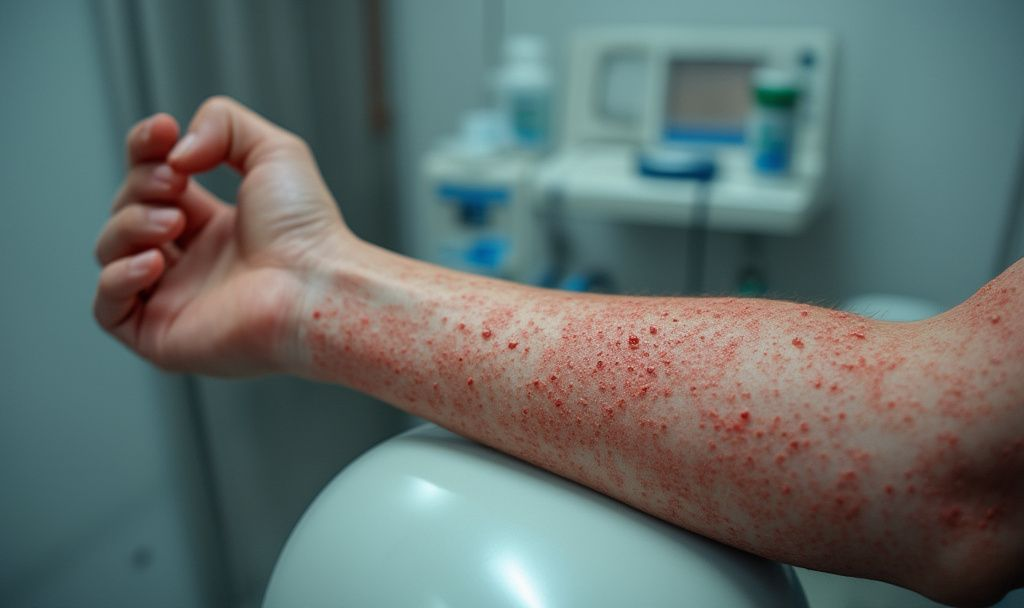- By Halima Orozco
- • Last Updated
Understanding Psoriasis: Pictures and Insights
Curious about how psoriasis appears on the skin? By examining psoriasis pictures, you can gain visual insight into this chronic condition, characterized by red, inflamed patches. These images help those seeking to recognize symptoms or understand their personal experiences with psoriasis better.

Understanding Psoriasis Through Images
Psoriasis is a chronic autoimmune skin condition that can be both confusing and distressing. Many seek to understand it better by searching for “psoriasis pictures.” These visuals reveal how the condition manifests, showing red, inflamed, itchy scales that can appear on different parts of the body. Viewing these images helps individuals compare their symptoms with documented cases, assisting them in recognizing or understanding their own experiences with psoriasis.
When someone encounters unusual skin symptoms, turning to pictures can provide clarity. It’s vital, however, to note the Mayo Clinic emphasizes that these images should not replace medical diagnosis. Psoriasis can be mistaken for other skin conditions like eczema, so consulting with a healthcare professional is always recommended.
Why People Search for Psoriasis Pictures
Individuals often turn to psoriasis pictures for self-diagnosis or to prepare for a medical consultation. For many, it’s a way to gain reassurance or to help them come to terms with a recent diagnosis. Seeing different images of psoriasis allows one to understand the diversity in its appearance, from the various types of psoriasis to how it looks on different skin tones.
Searches also tend to increase during times of heightened awareness, such as during Psoriasis Awareness Month in August. There has been an increased emphasis on providing images that adequately represent how psoriasis appears across different skin tones, as seen in resources from Cleveland Clinic.
Human and Emotional Impact
Psoriasis doesn’t just affect the skin; it can also take a toll on mental and emotional health. Those who live with psoriasis often experience stress, anxiety, and sometimes depression due to the visible nature of the condition. The need for understanding and community becomes even more significant as individuals seek comfort in knowing they are not alone.
Viewing psoriasis pictures can provide some solace when people see others with similar conditions, fostering a sense of belonging. This sense of community is important for reducing the isolation that can come with the condition. In fact, social media and support groups have become key platforms for sharing experiences and spreading awareness.
Resources for Exploring Psoriasis Images
If you’re looking to explore images of psoriasis, several trusted medical sites offer comprehensive galleries. The NHS website and Healthline present detailed images that show different types and severities of psoriasis. They represent how the condition may appear on various skin tones, aiding both self-recognition and medical understanding.
In addition to these resources, there are digital tools available that allow individuals to track skin changes over time. Apps like Miiskin and FirstDerm enable users to compare their symptoms against a database of images, but it’s important to use these in conjunction with professional medical advice and services.
The Broader Context and Considerations
The treatment and understanding of psoriasis reach far beyond just images. The pharmaceutical industry is continually innovating new treatments, from topical creams to systemic medications. Meanwhile, dermatology experts stress the importance of diverse representation in medical imagery, ensuring that those with darker skin tones are not left at a diagnostic disadvantage.
While searching for images can provide insight, it is crucial for these resources to complement professional healthcare. Ethical considerations, such as maintaining an inclusive portrayal of all affected by psoriasis, are vital for accurate diagnosis and effective treatment plans. As awareness grows, so does the potential to combat the stigma and misconceptions historically associated with psoriasis.
Frequently Asked Questions (FAQs)
What does psoriasis look like on different skin tones?
Psoriasis can appear as red, inflamed patches on lighter skin tones and as purple or brownish scales on darker skin tones. Resources like Healthline and the NHS offer images showing these differences.
How can psoriasis be differentiated from eczema?
Psoriasis commonly presents as well-defined, silvery scales, whereas eczema tends to manifest as a red, itchy rash without the thick scales. A healthcare professional can provide an accurate diagnosis.
Why do people search for psoriasis pictures?
People often search for psoriasis pictures to understand their symptoms better, self-diagnose, or prepare for a medical consultation by comparing their skin with documented cases.
How do psoriasis pictures help those with the condition?
Viewing images can help individuals recognize the diversity of psoriasis and offer reassurance by showing that others share similar experiences, fostering a sense of community.
Where can I find trusted images of psoriasis?
Reputable medical sites like the NHS and Healthline offer comprehensive galleries of psoriasis images that depict different types and severities of the condition on various skin tones.



